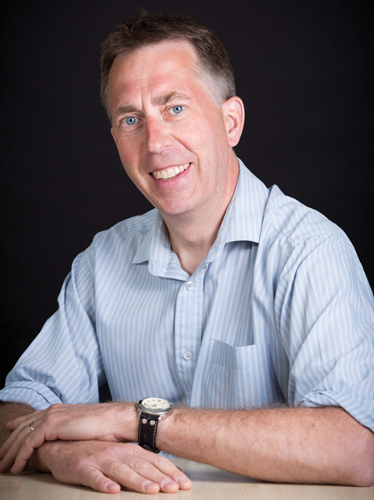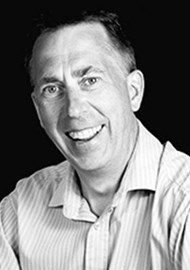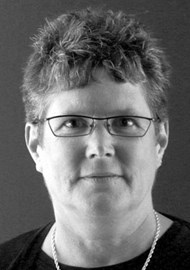
Can you start by telling me something about your own background?
After my first degree in Psychology at Reading and a year doing other things, I went to Southampton to do the MSc in 1982. My first job after that was as the single-handed audiologist at Mayday Hospital in Croydon – following that I got the opportunity to work on the tinnitus research programme at University College Hospital (UCH) in London with Jonathan Hazell. That was an interesting, albeit intense couple of years gathering data on the effectiveness of tinnitus maskers and other devices. At that time the early stages of the UCH/RNID (now Action on Hearing Loss) cochlear implant programme were just beginning and I was very lucky to be part of the team, led by a great man called Graham Fraser, that started using the first generation of (single channel) implants in the country and went on to establish cochlear implantation in the United Kingdom (UK). They were fascinating and exciting times, and I met a lot of good friends and colleagues. I went on to be coordinator of the cochlear implant programme there for a few excellent years until moving to Birmingham in 1991 to become the manager of audiology services for south Birmingham – at the time that included both Birmingham Children’s Hospital and Queen Elizabeth Hospital.
Over the years since I have concentrated on adult work and have focused on the leadership and development of the adult hearing service now based in our new department at Queen Elizabeth Hospital Birmingham. I am lucky to work with a great team of talented and dedicated people, and we have, what I think is, a special combination of skills and experience centred on adult audiology, in particular rehabilitation for hearing loss, balance and tinnitus in all its forms, with a particular focus on implantable devices.
What keeps you motivated and what drives you?
I love my work and the whole field of audiology and hearing – so I am naturally motivated by the work we do; also, I enjoy continuously improving what we do and striving to do the best. In audiology we are lucky that we can give people enormous benefits and so there is always great job satisfaction.
You’ve worked in the field of cochlear implants for a long time – what took you in that direction in audiology practice?
Originally, it was by chance that I was working at UCH when the UCH/RNID cochlear implant programme began in the early 1980s – I rapidly got sucked in and it was an exciting time as we felt like we were breaking new ground constantly. Since then, the field of cochlear implantation has grown enormously but has maintained its fascination for me; there are so many aspects to it, including the scientific interest and the obvious human side.
What have been the key changes you’ve seen in cochlear implants and how do you think things might develop in the future?
Cochlear implants have, over the years, matured from being somewhat experimental and exotic devices for a small number of people to a mainstream treatment for deafness. The technology itself has constantly improved, and expectations of the quality of hearing that can be provided have increased accordingly. It is now routine to expect adult patients to gain useful open-set speech discrimination, and for children implanted at a young age to grow up with near-normal speech and language; this was unheard of years ago. The controversy surrounding implants, particularly for children, is still there in parts of the deaf community but is no longer such a huge issue as it once was - that is a result of the recognition that is now out there of the huge benefits that implants can bring. The selection criteria for cochlear implantation have relaxed progressively over the years and can be expected to relax further. We now know that people with some usable hearing, but who struggle with hearing aids in day-to-day life, can get greatly improved hearing from a cochlear implant; there is also now much more evidence of the benefits of bilateral implants, which are now routinely offered to children.
The technology will continue to improve, but there is inevitably a limitation to the amount of information that can be provided to a deaf ear via electrical stimulation. In the future we can expect to see more people with unilateral deafness receiving implants (if the funding for that is available), and probably also more people with less severe hearing loss. The other fascinating area is the perception of music by cochlear implant users – this may become a topic for much more interest in the coming years.
You were awarded your PhD from Aston University in 2006 – can you tell me a bit about your studies and what challenges you found in combining part-time study and a clinical management role?
My PhD research focused on auditory grouping in cochlear implant listeners. In normal hearing, the perceptual process of auditory grouping (also referred to as auditory streaming) enables the auditory system to perceptually group together sounds that have common characteristics. This ‘Auditory Scene Analysis’ is the process by which the auditory system takes the complex mixture of sounds that is delivered to our ears from the environment around us and sorts it into ‘packages’ of acoustic evidence, in which each package has arisen from a distinct source of sound.
This process has been studied extensively in normal hearing listeners but little in cochlear implant listeners. I carried out a series of experiments with cochlear implant users to investigate whether those cues that can be used in normal hearing for grouping are also available and useful in electrical hearing; overall, my results suggested that it is very hard to demonstrate any evidence of auditory grouping in cochlear implant listeners. This goes some way to explain why they find complex listening situations so challenging and rely on good signal-to-noise ratios to follow speech and other sounds. Carrying out this research for a PhD part-time while still working was a huge challenge, but the research itself was so fascinating and absorbing that my determination to complete it was never shaken; I was also very lucky to have a great supervisor, who helped push me along all the way through!
I’d like to turn to the British Society of Audiology (BSA). Maybe you could start by outlining the work the Society has undertaken recently?
This has been a busy couple of years for the BSA, under the leadership of the chair Kevin Munro. We have planned the work of the society using an Action Plan, which focused on the key strategic areas of publicity and communication, the BSA expert advisory role, inter-disciplinary interface and networking, and the key work of the professional practice committee.
The recent launch of the new website for the BSA has been a great boost to raising awareness of our activities and hopefully this will become known as a ‘go-to’ source for all matters relating to audiology and hearing. One of the most current issues is the proposed decommissioning of hearing aids for mild and moderate hearing losses in North Staffordshire. The BSA, along with the other main organisations, has been very active in gathering evidence and challenging this decision; we will continue to work with others who all agree on the nonsensical nature of this proposal to fight it. One other area of increasing activity has been the LEG (Learning Events Group) which has developed a vibrant programme of educational events throughout the year, including ‘lunch and learn’ seminars, evening meetings, and journal clubs, as well as the annual conference which is again in Keele this year. We hope that all these events will help our strategic aim of enabling inter-disciplinary interface and collaboration between clinical and academic scientists which is vital for the future of audiology. Further to this aim, the BSA research fund supports small projects which bring together academic researchers with clinical audiologists with good research ideas – we would like to see more uptake of that opportunity. Finally, the new BSA magazine Audacity has been a huge success and I thoroughly recommend it to anyone in search of a really good read.
You will be taking on the Chair of the BSA from September 2014. What do you see as the key challenges for your term in office?
One key challenge will be bringing together the different ‘branches’ of audiology and hearing research – the academic world and clinical audiology. I hope we can do all we can to work together and forge collaboration. As mentioned already, BSA will also have a key role in providing expert scientific advice and knowledge to help challenge changes threatening the profession, such as the threatened withdrawal of funding for hearing aids in North Staffordshire. I would like to see BSA strengthen its historical reputation as the source of scientific knowledge on all matters relating to hearing and balance, and I know we have the people in the society to achieve that. Another challenge is to increase membership – this will be helped by continuing the process of modernisation already begun under Kevin’s chairmanship but perhaps more needs to be done to shake off the old image of the BSA as a somewhat fuddy-duddy learned society; to this end, we will make much more use of modern social media and the great new website. The imminent appointment of a new Operations Manager for the society will be a great boost and I look forward to working with him or her to get things done.
The BSA has a new website – can you tell me a bit about its development and what you hope the membership will gain from it?
We recognised that many of the aims of the BSA were hindered by the lack of an up-to-date, modern-looking and current website, so following a tender process have worked with an excellent web developer to create the new site. The membership will gain an invaluable source of news, information, and interesting stories. I hope the new website will become the main source of current information for anything related to audiology, hearing and balance; we are putting together a small team to maintain and update the site which will ensure that it is fresh, current and interesting.
Do you have any information available about the next BSA annual conference?
This year’s conference will again be in Keele and the organisers have put together an excellent programme which will interest both those from the research community (originally the experimental short papers meeting) and clinical audiologists. This is an important opportunity for inter-disciplinary interface and networking, and as at last year’s conference there will be an ‘innovation forum’ which will enable anyone with an interest in the future work of the BSA to contribute to talking about new ideas for the work of the society. Can you tell us something you enjoy when not at work? What do you like to do when you are away from audiology? Away from audiology, I love being with friends and family, walking and cycling in the Warwickshire countryside, photography, and when possible visiting beautiful Pembrokeshire.
Interview conducted by Amanda Casey.





